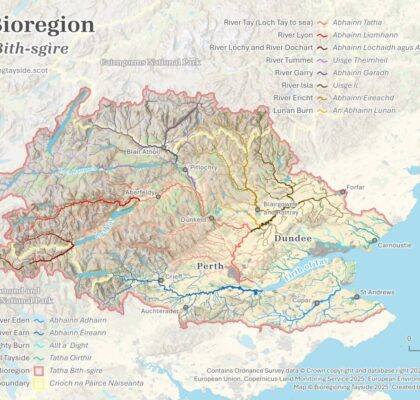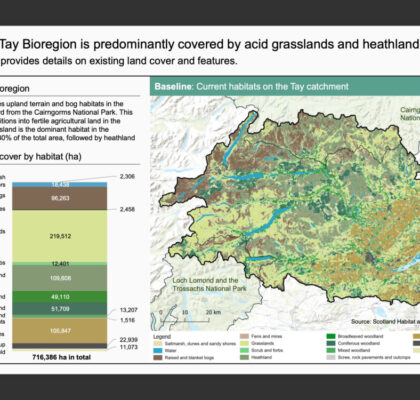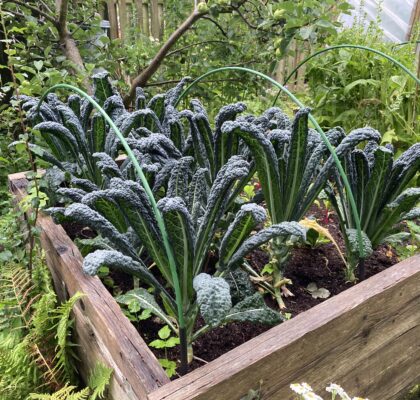Bioregioning Tayside’s latest and most ambitious project to date has been to begin building Scotland’s first Bioregional Financing Facility (BFF). The team is now expanding thanks to funding from the Systemic Climate Action Collaborative and we are delighted to welcome Rosa Brand. Read our interview with Rosa below to find out more!
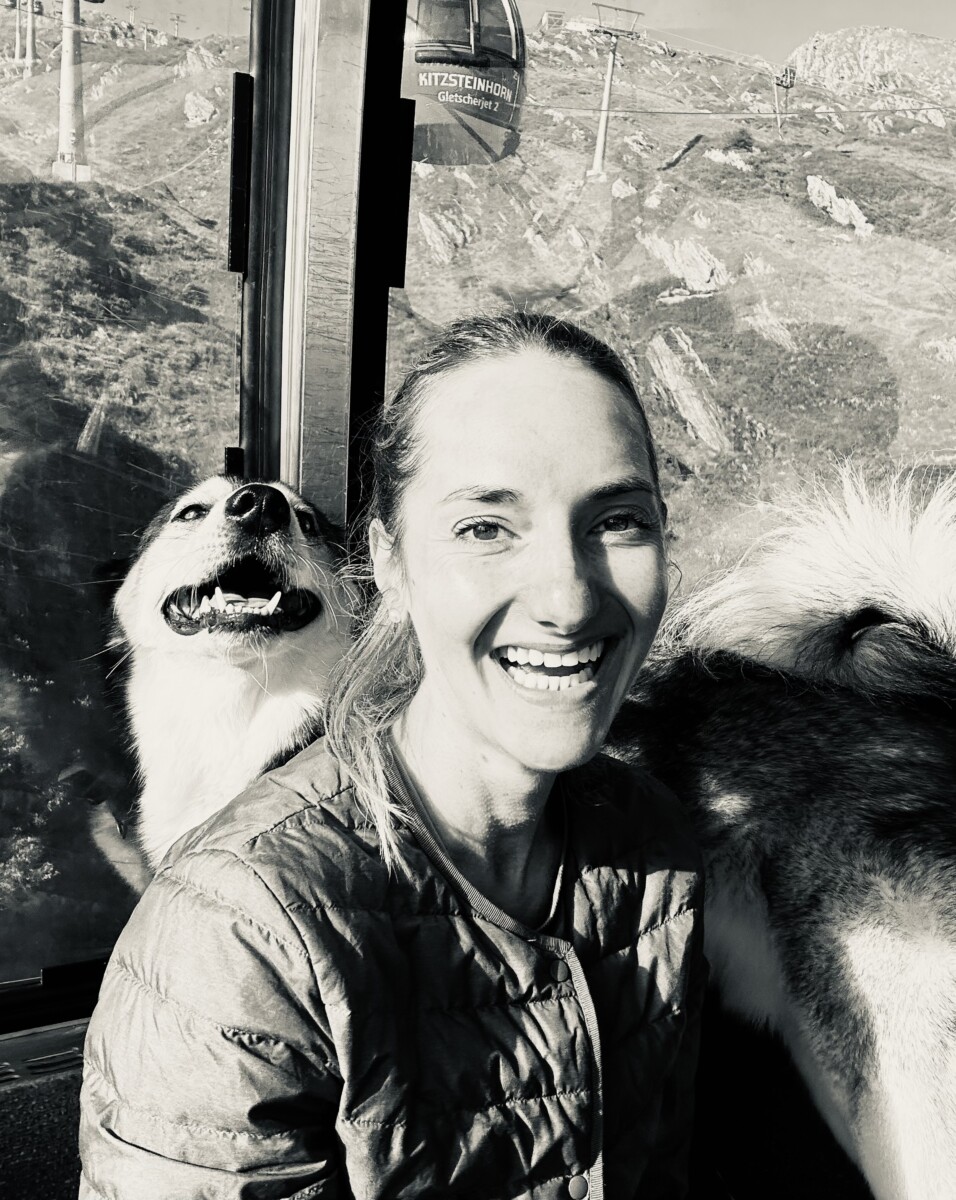 Rosa in the Austrian mountains
Rosa in the Austrian mountains
Tell us about yourself Rosa and your route into the world of Bioregional Financing Facilities (BFFs)?
I grew up in Vienna, Austria. Although I was raised in the city, I spent every summer climbing trees, foraging for wild strawberries in my grandparents’ garden, and hiking in the Alps. I was also a deeply curious, nerdy kid – always reading, across genres, though I especially loved science fiction and fantasy.
From an early age, I felt frustrated by how siloed so many parts of life seemed – starting with education. The strict separation between subjects felt artificial to me; I always found topics far more engaging when they were connected and placed in context.
Somehow, I ended up studying business and management, mostly because I was curious to live abroad and loved learning languages, and that degree required both. I graduated during the financial crisis and decided to pursue another degree, eventually completing a master’s in finance. Over the years, I studied and worked in Australia, Canada, Spain, Portugal, and Mexico, before landing in London to work in the financial sector. By chance more than design, I specialized in real estate investment – first in credit, then in private equity.
I stayed in finance for many years, though I never quite felt at home. I was always drawn to a variety of other topics like neuroscience, physics, meditation, biology, and history. Still, the job was varied enough to keep me engaged – until I took some time off between roles. During that break, I returned to an old preoccupation: how disconnected and fragmented our systems are, and how contradictory that is to what we know from science – especially physics – about the fundamentally interconnected nature of the world.
I went back to work again, and those thoughts got shelved. But over time, I began to question more deeply. I had always been aware of issues like climate change, biodiversity loss, and rising inequality – but I had assumed there were experts, grown-ups somewhere, who had things under control.
Then, last year, a few things shifted dramatically. First, I discovered complexity science and systems thinking – which felt like a revelation. It gave me the language to articulate what I’d been sensing all along: that everything is connected, and that the structures we live in are deeply interdependent. I also took a course on systems thinking for sustainability that made the depth of our global crises (and their interconnectedness) impossible to ignore. And perhaps most importantly, I realised: no one’s coming to save us. There’s no single institution or leader who has this figured out. It’s up to all of us.
At the same time, my industry was facing significant challenges, which gave me an opportunity to step back and fully immerse myself in a learning journey focused on systems thinking, complexity, and sustainability. Once I understood what I now know, going back to a traditional finance job no longer felt possible – or ethical.
Around that time, I began following the work of Dark Matter Labs, and especially their exploration of Bioregional Financing Facilities. It resonated deeply. Here was a project that brought together so many of the themes I’d been thinking about: the interconnectedness of systems, the climate and biodiversity crises, food and water security, soil degradation, inequality, and the fraying of social cohesion.
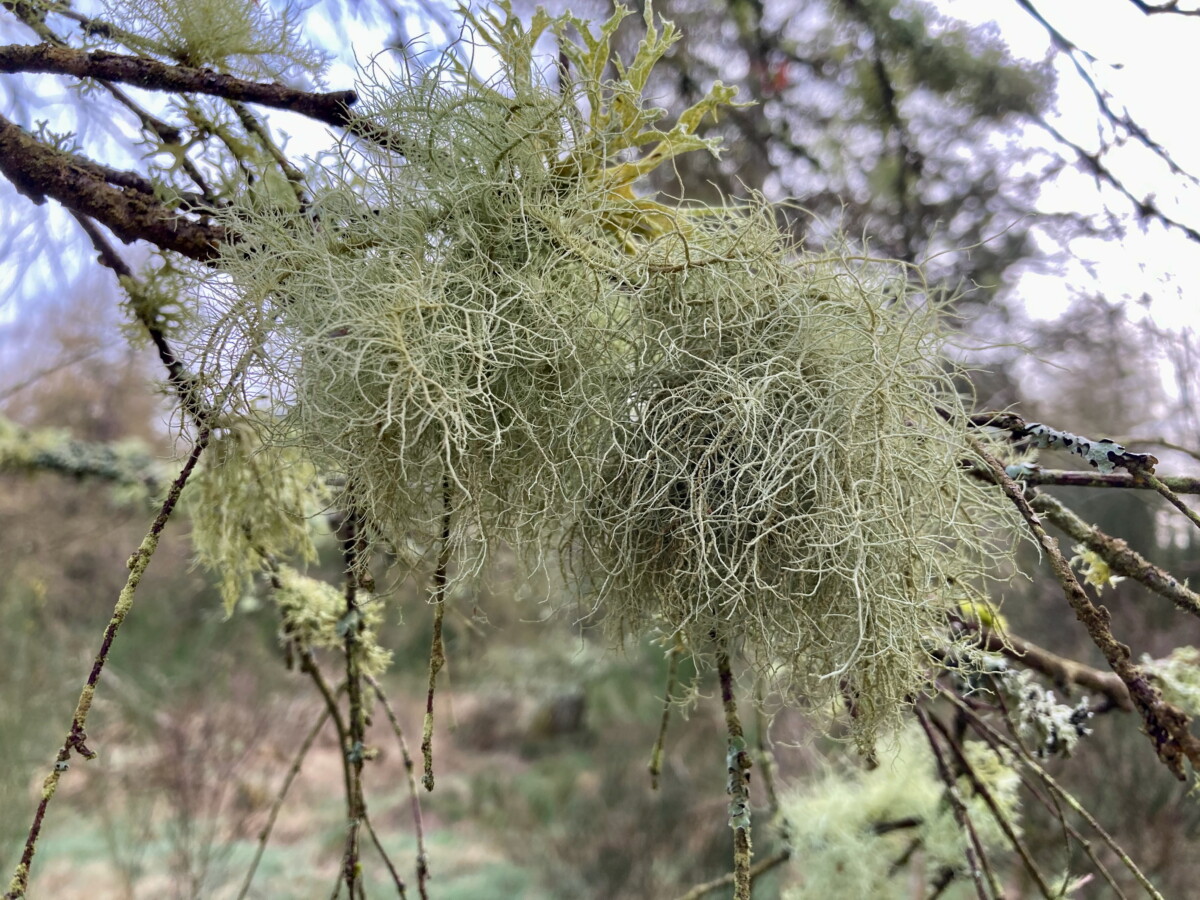 Tree lichens in the Braes of Angus, photo Clare Cooper
Tree lichens in the Braes of Angus, photo Clare Cooper
When I had the opportunity to join the team and work on this initiative, it felt like the most natural next step. I feel incredibly lucky to be part of this work – and to be collaborating with such an inspiring group of people.
Interest in Regenerative Financing (ReFi) is growing across the world, what trends and patterns are you noticing and what distinguishes BFFs within the broad ReFi philosophy and approach?
That’s a great question – as you say, interest in Regenerative Finance (ReFi) has continued to grow. Interestingly, this is not driven by a single actor, but across a broad range of communities, investors, and policymakers, who have come to the conclusion that currently existing extractive financial models have failed their communities and our planet, and are looking for alternatives. Some of the key trends we see emerging are:
- Localisation of Finance: There is a growing recognition that the pendulum has swung too far toward standardisation. The current globalised, one-size-fits all solutions feel increasingly disconnected from the reality of communities who are dealing with a wide array of disparate challenges. This has led to a renewed emphasis on creating place-based financial mechanisms that are better suited to specific ecological and cultural contexts.
- Community Governance and Participation: This tendency to move away from the current top-down approach is also reflected in the way decisions are taken. We are seeing more and more experimentation around decentralized governance models (often using blockchain) that are designed to enable more inclusive decision-making and community ownership in financial flows. Ultimately, the aim is to move away from an “interventionist” approach where capital flows into a region to fund a specific project and then disappears again, to a more permanent approach that establishes the foundations for the bioregion to manage its regenerative potential over the long term without having to depend on short term capital allocations from outside parties.
- Integration of Natural Capital: Our current financial system is based on the illusion that humans are separate from nature. This has led to a situation where the very ecosystems we are part of and depend on for our survival have been degraded to an extent where they are at risk of collapse. ReFi initiatives are experimenting with different ways of overcoming this inherent flaw in the system, for example by trying to put a value on ecosystem services (like carbon sequestration, water retention, and biodiversity) so that they can be integrated into economic decision-making.
- Blending Finance for Regeneration: The siloed nature of our financial system means that different types of capital (that have different goals and requirements) are managed by separate advisors and through a set of entirely different structures. This lack of coordination means that the synergistic effects between those types of capital often go unnoticed, for example where a grant could be used to de-risk a project which then allows private capital to come in. There is now momentum around blending these different types of capital in order to unlock long-term regeneration projects that wouldn’t attract traditional finance.
How does BFF fit into this picture?
I know the Bioregioning Tayside team is a big fan of Merlin Sheldrake’s book “Entangled Life”, so I’ll use a fungi metaphor to explain how I think about the connection between ReFi and BFFs. In my mind, Regenerative Finance is like the mycelium – the vast, interconnected underground network of fungi that supports forest health. It’s a distributed, adaptive system that connects different parts of the ecosystem, channels nutrients, and enables communication across long distances. In a similar way, ReFi provides the underlying philosophy, infrastructure, and technical tools (e.g. DAOs, tokenisation, ecological accounting). Bioregional Financing Facilities (BFFs) are also part of this system, but they are like the fruiting bodies – the visible, place-based expressions of that larger network. Mushrooms emerge when conditions in a particular microclimate are just right – just as BFFs emerge when local ecological knowledge, community leadership, and capital converge in a specific bioregion. They are the locally adapted, regenerative financing structures that manifest the ReFi principles in a tangible, grounded, and ecologically appropriate way. So in summary we can say that, while each BFF may look different (shaped by its unique ecosystem), they all are nourished by the same underlying regenerative logic. And together, they form a resilient, adaptive financial ecosystem capable of restoring landscapes and livelihoods.
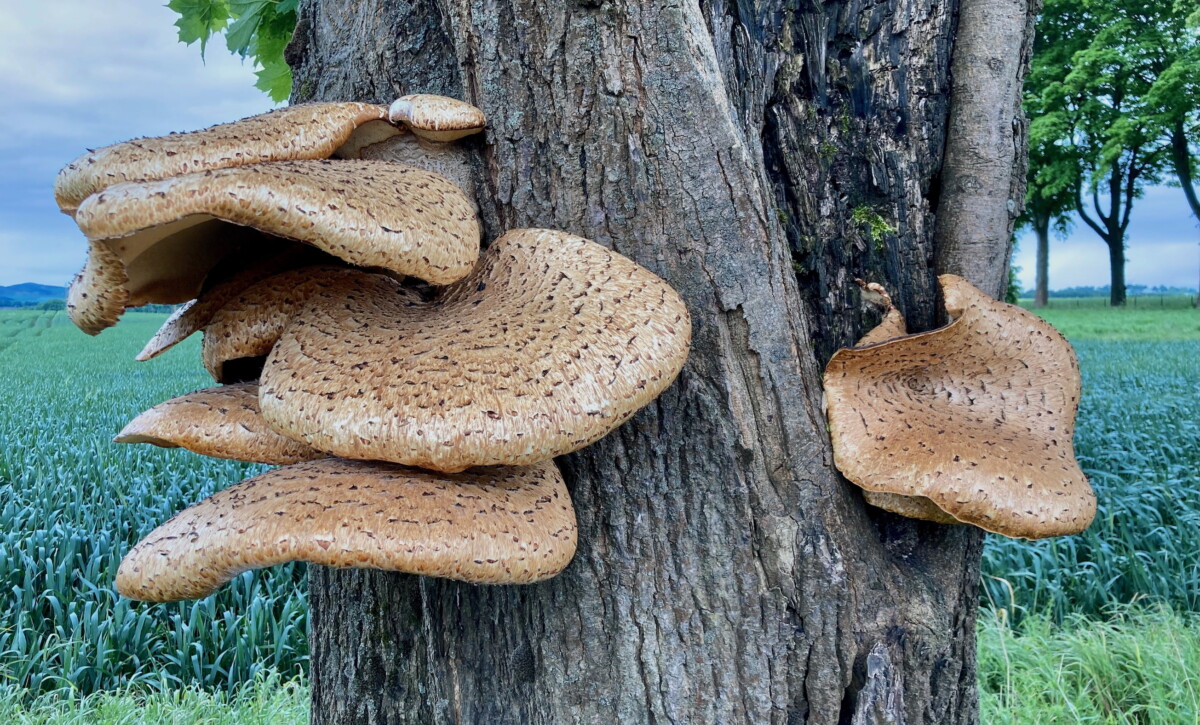 Dryad’s Saddle Fungi on Strathmore, photo Clare Cooper
Dryad’s Saddle Fungi on Strathmore, photo Clare Cooper
We completed the first stage of work for the Tayside Bioregional Financing Facility at the beginning of the year (link), can you explain what the second stage we have now embarked on involves and what your role is in that?
The first stage of the work was about understanding where Tayside currently stands. In this stage, we assessed the ripeness and readiness conditions for developing the facility across 15 key elements. Based on that assessment, we identified and plugged a number of critical gaps to strengthen the foundations for the next phase. We also spent time reflecting on Bioregioning Tayside’s own role in this landscape: What are the values BT wants to embody? What’s the theory of change? What role can the organisation play in facilitating regeneration? With this groundwork done, we’re now moving forward into the detailed design of the BFF.
But this isn’t a checklist where you finish one task and move to the next. It’s more like weaving – or even better, a spiral. Each strand we explore helps move another one forward. The work is non-linear, deeply interconnected.
In this next phase, we’re starting to lay more tangible foundations. For example, we’ve begun mapping ecological regeneration opportunities across the bioregion, such as areas suitable for reforestation, wetland restoration, or regenerative agriculture. That ecological mapping helps unlock the next layer of questions: how do we design financing mechanisms that reflect and support these opportunities? How do we begin to assign value – not just financial, but ecological and social – to this work?
Once we’re engaging with the question of value, governance naturally follows. If there’s economic value tied to these projects, who decides how capital is allocated? Who guides priorities? These are complex, layered questions – and they open up space for innovation.
At the same time, we’re keenly aware of the urgency. We can’t spend the next decade designing the perfect governance model or funding structure while biodiversity declines and topsoil continues to erode. Great regenerative projects already exist, and they need support now.
So rather than waiting for perfection, we’re choosing to move forward iteratively: starting small, testing mechanisms, learning by doing, and evolving the model over time. Our long-term vision is to build a funding structure that ties investment returns directly to the health of the bioregion – not just in terms of carbon sequestration, but also biodiversity, water quality, soil health, and social cohesion. That’s what we’re working toward – step by step, spiral by spiral.
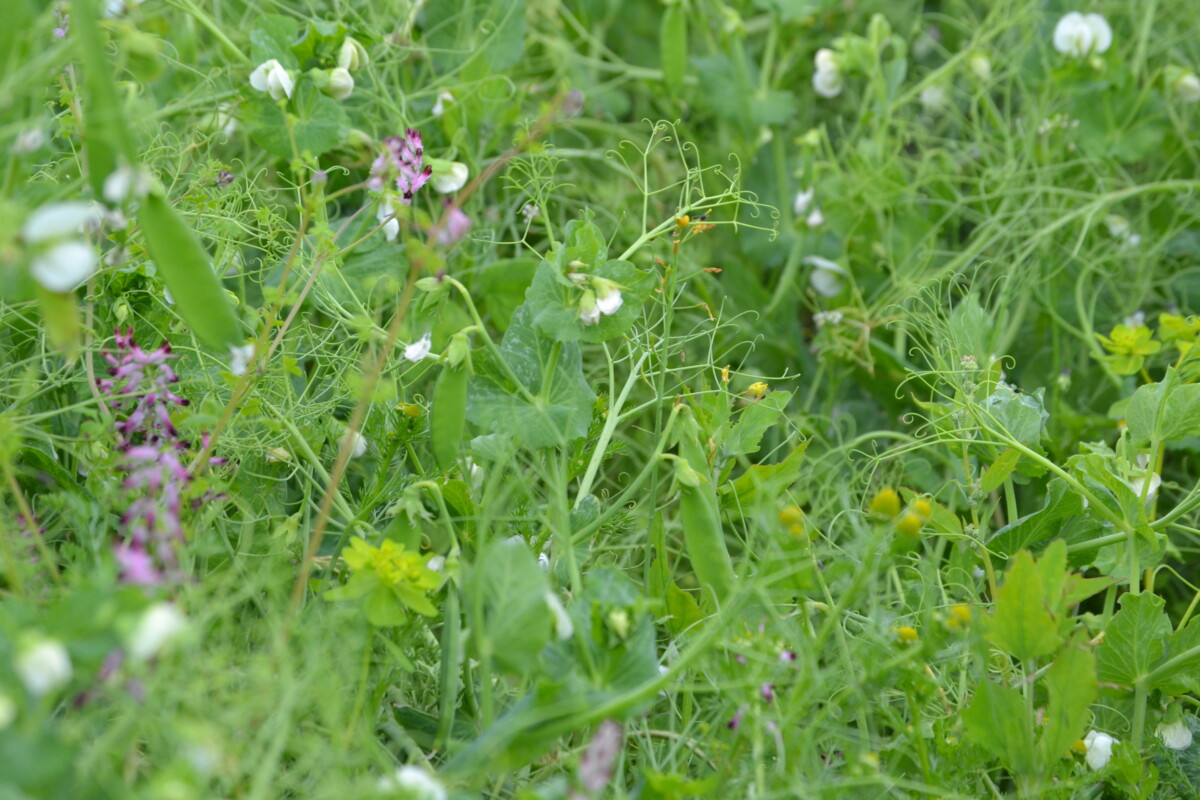 peas growing in Strathmore, photo Clare Cooper
peas growing in Strathmore, photo Clare Cooper
We’re hoping to get some BFF pilots activated in 2025, are there any particular kinds of projects you would like to see being put forward in this first round?
What’s most important to us is that the projects are deeply rooted in the local community. We’re not looking to impose priorities from the outside – instead, we want to listen and learn from the grassroots to understand what’s urgent, what’s already happening, and where support can be most catalytic.
A key part of this approach is the Bioregional Plan that Bioregioning Tayside is currently co-creating with local communities. This Plan will combine robust, evidence-based data on the state of local ecosystems with insights from communities themselves about what they see as the most pressing priorities. Ultimately, this Plan will serve as the guiding North Star for our financing and investment strategy, ensuring that the projects we support reflect local ambition and deliver real, lasting impact.
There are already many incredible projects across Tayside and beyond. In this first round, it’s not just about finding what’s new and shiny – it’s also about recognising what’s already working. Some of the most impactful projects may be those that are already delivering results and just need support to scale, replicate, or evolve.
We’re also aiming for diversity in every sense:
- In themes: whether it’s regenerative agriculture, biodiversity, carbon sequestration, local food systems, community-owned energy projects, or storytelling and cultural mapping.
- In approaches: some projects might be hands-on and community-led, others might involve developing remote sensing technologies or new financial models.
- In scale: from small, hyper-local initiatives in a single community, to system-level interventions or tools that could scale across the bioregion.
- In sectors: we want to see initiatives from public bodies, private landowners, community groups, and social enterprises.
- And especially in people: we’re not just looking for people who naturally think of themselves as entrepreneurs. We want to support people of all ages, backgrounds, and lived experiences – farmers, artists, scientists, educators, carers, elders, youth groups.
We’re also thinking about time horizons. Some projects might be more short-term and practical – what we might call “Horizon 1” work – with immediate, tangible outcomes that can be realised in the existing system. Others might be more visionary or experimental, aligned with a “Horizon 3” mindset, reimagining what land, finance, or stewardship could look like in the future. Both are needed – and everything in between.
Personally, I’d love to see projects that create a kind of social contagion – initiatives that not only have an impact themselves, but inspire others in the community to get involved, to imagine what’s possible, and to launch their own ideas. That sense of momentum and shared creativity is what will really help regenerative economies take root.
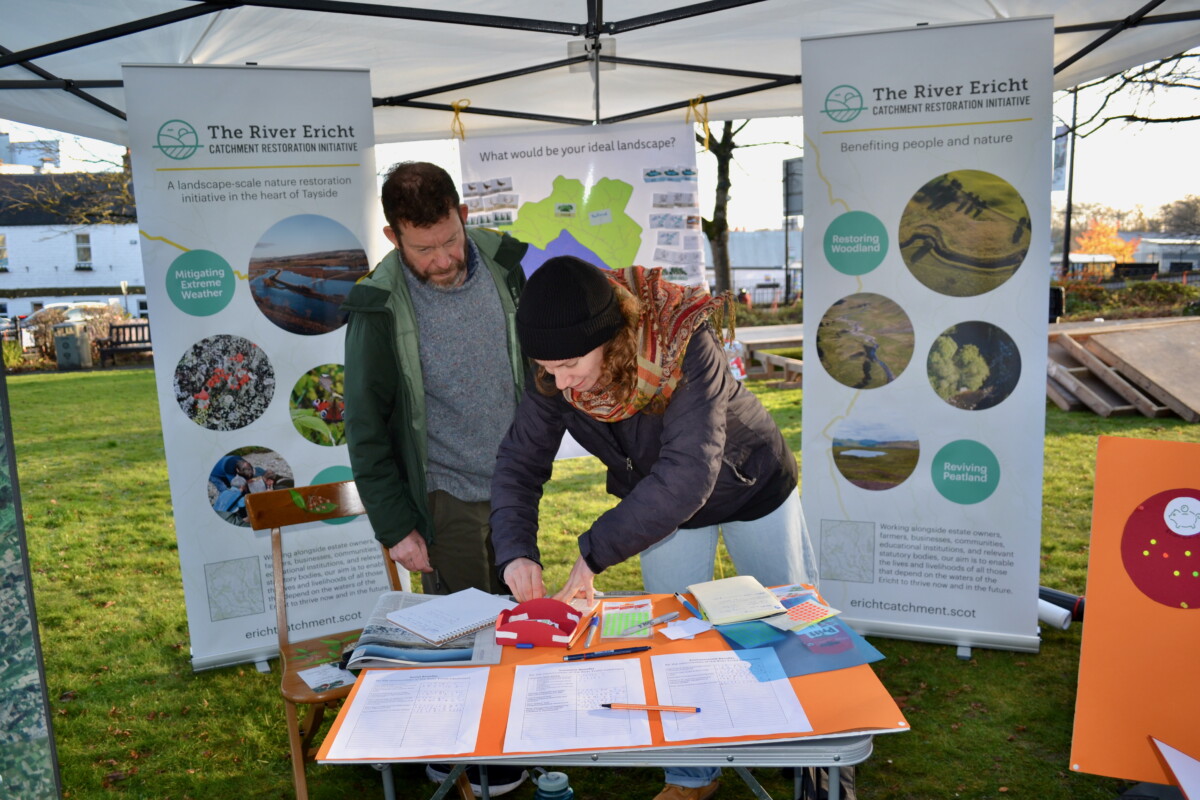 Community Consultation event for the River Ericht Catchment Restoration Initiative, November 2023, photo Clare Cooper
Community Consultation event for the River Ericht Catchment Restoration Initiative, November 2023, photo Clare Cooper
Creating BFFs is a very new and emergent field, what advice do you have for the Bioregioning Tayside team on how to navigate the challenges we will inevitably face?
Creating Bioregional Financing Facilities is indeed a new and emergent field, full of uncertainty and complexity. My advice to the Bioregioning Tayside team (and really any team working in this kind of environment) is to focus first and foremost on building psychological safety. Make sure everyone feels safe to speak openly, to share doubts, concerns, and ideas without fear of judgment or retribution. This openness is essential when experimenting and navigating uncharted territory.
Be willing to experiment boldly, and accept that failure is part of the process. What’s critical is learning quickly – reflecting regularly on what works and what doesn’t, and adapting accordingly. This iterative mindset keeps the team resilient and responsive.
Regularly return to your core values and purpose. In environments of rapid change and complexity, it’s easy to get caught up in daily pressures and lose sight of the bigger mission. Holding your shared purpose front and center helps prevent mission drift and aligns decisions, even when the path forward is unclear.
adrienne maree brown’s Emergent Strategy offers powerful guidance here. She emphasizes the importance of small, adaptive actions – moving in sync with the natural rhythms of the system you’re working in, rather than trying to force big changes all at once. She also highlights the power of relationships and interconnectedness: leaning into the collective intelligence of diverse voices, and nurturing the health of the whole community over individual ego or hierarchy.
What’s truly special about the Bioregioning Tayside team is the diversity of expertise and personalities – each member brings something unique, and together those differences create a rich, complementary skill set. But beyond skills, what stands out most is the immense care everyone shows – not just for the work itself, but for each other and the relationships within the team. That kind of trust and mutual respect is a foundation for thriving amid complexity.
My encouragement is to continue nurturing that culture of care, openness, and learning. That’s the soil from which regenerative, transformative work can truly grow.
This entry was posted in News
